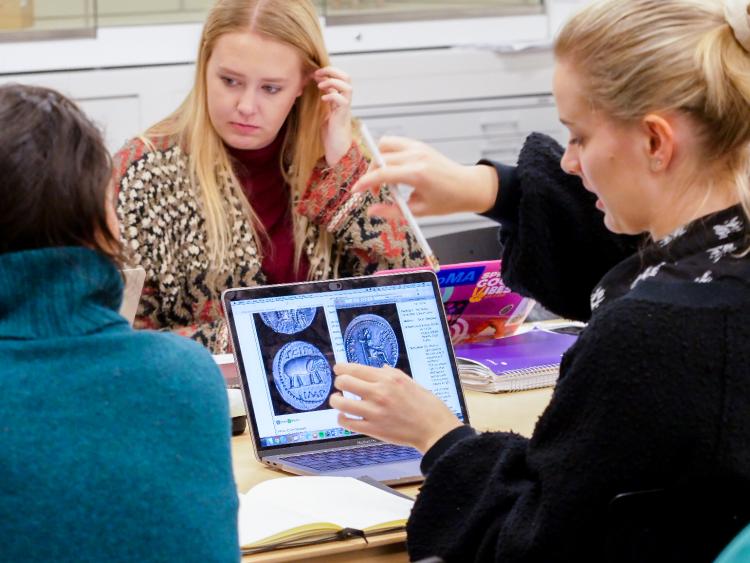Students collaborate with CU Art Museum on new Roman coin exhibit
One of Diane Conlin's goals is to encourage creative thinking among her students
In ancient Rome, coins were not just payment, but a form of communication and art.
The coins can tell wide-ranging stories about politics, resistance, religion, feminism and female sexuality in their contemporary world.

Students and auditors review ancient points in an Art of Ancient Roman coins class at the CU Art Museum. The students are studying the pictures on Roman coins as miniature works of art in the Collections Study classroom in the CUAM. Students, both undergrad and grad, work directly with the coins in small research groups to not only understand the artistic value of coins but to prepare proposals for an exhibition that will go up in the CUAM this semester. The coins they are working with are either CUAM objects or coins on loan from a local Boulder collector and CU donor. CU Boulder photos by Glenn Asakawa.
“The artistic exchange that took place between the anonymous creators of these coins, many of which were slaves, is fascinating to explore,” says Diane Conlin, associate professor of classics at the University of Colorado Boulder. Right now, the CU Art Museum’s Roman coin display is linear and chronological, she says. “I don’t know that our way is the most exciting way to tell that story.”
Students from Conlin’s cross-listed classics and art-history class, “The Art of Roman Coins,” are inserting their fresh perspective into the exhibit, set to open this spring. The exhibit will incorporate the Wink Jaffee collection of Roman coins—donated by a prominent Boulder resident and Roman-coin collector, the late Wink Jaffee—and a selection of coins owned by the CU Boulder Natural History Museum.
Conlin helped students analyze the coins and create proposals on how to best display them to engage museum-goers. One of Conlin’s goals is to encourage creative thinking among her students. “I want to be able to give them an opportunity to shine in a way they normally wouldn’t be asked to in a classics class,” she says.
In their project presentations, students gave an “extended elevator pitch” of their exhibition ideas and floorplans in groups of three. Some incorporated technology like 3D printing replicas of Roman vases and sculptures to engage their museum audience, while others used QR codes linking to high-resolution images of the coins online. Museum staff will review their proposals and come up with a new exhibition based on a combination of student ideas, says Conlin.
Her students also collaborated with Hope Saska, curator of collections and exhibitions at the art museum, and Britt Scholnick, associate collection manager and registrar, to learn the “nuts and bolts” of a good exhibition proposal, and how to properly handle the coins, access information through the museum’s database for their research and how to leave their “disciplinary jargon” behind.
“I think in general, students tend to think about their audiences being their professor or their fellow students,” Saska explains.
“In this context, they really had to think about their audience as anybody who walks in the front door of the museum. They may be people who have very limited experience with art, or being in a museum context.”
This project aligns with the museum’s aim to increase interdisciplinary relationships across campus and “make impact in curricular development.”
Saska explains that fostering “meaningful intersections between courses and the museum” is a goal of the project, and that these relationships will raise awareness about the role of museums.
The interdisciplinary work the class completed with the coins and the museum will hopefully reveal other possible avenues of collaboration, Scholnick says. Engaging with Women and Gender Studies about the depiction of women on coins, with economics about their monetary value, perhaps even with chemistry to explore their precious metals, are all potential areas of research.
As for the final exhibit, Scholnick says, “I don't know what the selection of topics is going to look like, but I do think this is going to enable us to be a lot more interdisciplinary.”
The CU Art Museum's exhibition of the students' "recuration" will go on display April 2 and is expected to be remain open for several years.


